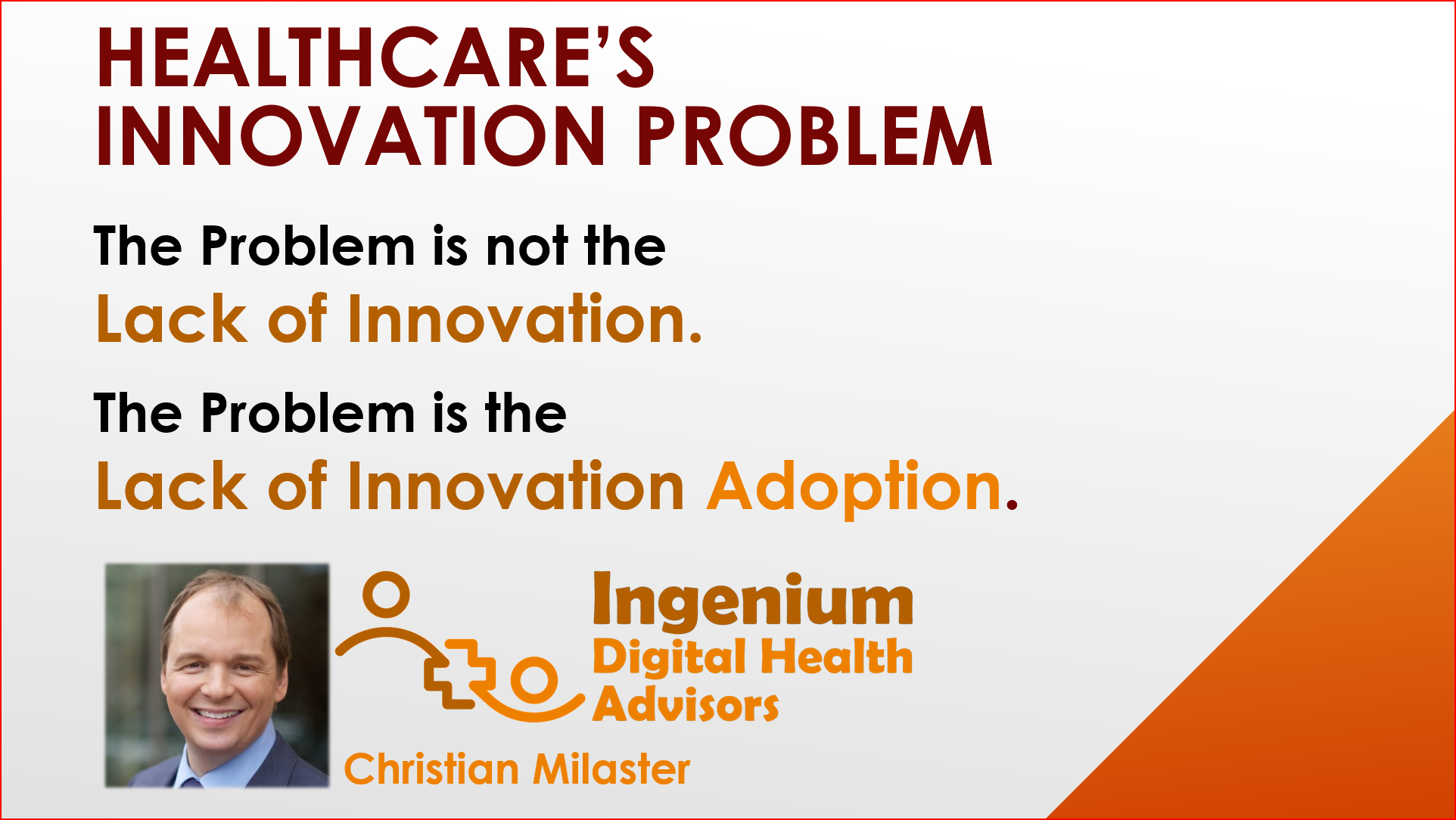“The Problem in Healthcare is not the
Lack of Innovation.
The Problem is the
Lack of Innovation Adoption.”
— Christian Milaster
Innovation, especially in healthcare, seems to be the “name of the game” these days. Everybody in healthcare is talking about innovation — digital health, artificial intelligence, virtual reality, augmented reality, and so on. It’s long been the buzzword, the darling of the venture capital community and what CEOs have to focus on in their update to shareholders or the board.
And many amazing, useful solutions have been and are being developed that can make a real difference in improving people’s health, including early recognition of disease onset, more accurate diagnoses, personalized treatment, revolutionary therapies, etc.
The challenge is that the traditional healthcare delivery system is very ill-prepared to efficiently and effectively adopt this innovation and integrate it into their care delivery systems.
Over a series of articles, I’ll be tackling this fascinating, rich and utterly important topic with plenty of practical guidance along the way.
But these articles are not going to be focusing on the creation of innovative solutions; plenty of articles and books have been written about that.
No, this series is focusing on a largely overlooked aspect of innovation:
Innovation Adoption
Think about it: Without adoption, innovation is useless.
The coolest gadget, the coolest scientific method has no value, if no one is using it.
What good would a hammer do, if no one was using it? Just grab the nearest rock and pound that nail in. It worked before, right? Why learn how to use that weird t-shaped thing?
I’m not focused on large academic medical centers with large research budgets. Or wealthy health systems with their own innovation ivory tower (though those have their challenges, too).
My mind is focused on (and my heart goes out to) the health centers, clinics, critical access hospitals, behavioral health agencies and local health systems. Those organizations, who in the 3rd year of the Covid-19 health crisis are suffering emotionally and financially due to governmental sequestration, a shrinking (and burned out) workforce, quiet quitting, eroding business models, etc.
Many of these organizations are in constant firefighting mode, rewarding the heroics of individuals “saving the day”, with little bandwidth and energy to strategize, to plan, or even to take a breath — let alone to focus their attention on innovation.
As Einstein quipped: “The definition of insanity is doing the same things over and over again and expecting a different outcome.” But once an organization is stuck in this hamster wheel of insanity, it takes a courageous leader to step outside and redirect the energy — even if initially chaos ensues.
“The future is already here. It is just not evenly distributed.” was an astute observation by writer William Gibson. In this case it means that the (innovative) solutions to the problems have already been developed. One must just find the right one and adopt it.
A few weeks back I wrote that wicked problems require wicked solutions. There is no magic bullet, no one solution that will solve the problems at once. It will take a series of innovations (and improvements) to tackle the challenges. Which is why it is paramount for healthcare to learn how to accelerate the adoption of innovation.
The current situation in this VUCA world is caused by many factors — the Covid-19 health crisis, the growing cost of care, the clinician shortage, the great resignation, the digitalization of healthcare, the accelerated pace of change, and fast-paced evolution of payment models, just to name a few. With so many “root causes”, many innovative solutions are needed to stabilize the situation and bring it to at least the resemblance of control.
Which brings me to the core concept that any organization must master first: the quick, rapid and almost effortless adoption of innovation.



Innovation Adoption
One of the founding fathers of the Mayo Clinic wrote in the 1930s: “The only constant is change.” — a quote that goes back to the old Greek philosophers, in this case Heraclitus.
But Innovation Adoption goes beyond the mere acceptance of change. Innovation Adoption means that one must first consciously discover the right innovation to adopt.
In addition, one must avoid having the tail wag the dog: Innovation should not be adopted for the innovation’s sake. Just because something is a cool solution (e.g., AI) does not mean that it can solve a critical problem.
Which brings us to a simple four-step process of Innovation Adoption:
- Define the Problem.
- Discover the Innovation.
- Develop the Integration.
- Deploy the Solution.
The best accelerant for ensuring the acceptance of innovation is to solve a pervasive, urgent, costly problem. Thus the leader’s challenge is to first pick and define a problem and then direct his team to discover the best innovation that solves that problem.
Here’s an example: Critical Access Hospitals are experiencing some dire times with dwindling resources, reduced funding, staff shortages, and lower than usual utilization. One of the last value-generating services is the concept of swing beds — a step down unit for seriously ill patients that cannot yet be released to a skilled nursing facility or to the patient’s home.
Given the pervasive, urgent, costly problem of low utilization or lack of adequate, cost-covering reimbursement for other services, we recently explored the use of telehealth (a digital health innovation) for virtual rounding by the referring hospital’s specialists. The goal: increase referrals to swing beds and initiate the transfer earlier, thus increasing the length of stay.
With the problem defined and the innovation discovered, the next — and oftentimes hardest step — is the integration of the innovative solution into the existing “engrained” care delivery processes.
Given our example, this requires the creation of a virtual rounding workflow for the distant specialist as well as for the staff responsible for the swing bed patient. It also requires the selection of a solution that aligns with the desired user experience by the clinicians, clinical support team, and the patient.
Once the solution integration has been validated through a proof of concept phase, it is time to fully deploy the solution.
Accelerating Innovation Adoption
The secret to the acceleration of innovation adoption lies in making this 4-step process (Define, Discover, Develop & Deploy) a core part of your organization’s “innovation adoption culture”.
This will take a whole slate of supplemental skill sets such as effective change management, systematic project management, fact-based management and a mindset of being constantly evolving and continuously optimizing.
How does your organization seek to accelerate the adoption of innovation? Or to start simpler: how does your organization systematically adopt innovation? I’d love to hear your answers!
The next article in this series is Innovation in Healthcare: The Innovation Prioritization Funnel.








To receive articles like these in your Inbox every week, you can subscribe to Christian’s Telehealth Tuesday Newsletter.
Christian Milaster and his team optimize Telehealth Services for health systems and physician practices. Christian is the Founder and President of Ingenium Digital Health Advisors where he and his expert consortium partner with healthcare leaders to enable the delivery of extraordinary care.
Contact Christian by phone or text at 657-464-3648, via email, or video chat.






